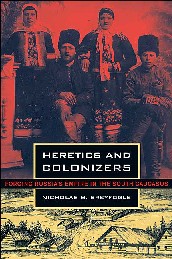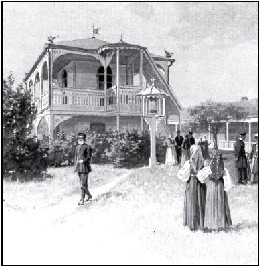Book Review by Koozma J. Tarasoff
Ottawa, Ontario. February 2006.Nicholas B. Breyfogle. Heretics and Colonizers: forging Russia's empire in the south Caucasus. New York: Cornell University Press, 2005. xii+347 pp. ISBN 0-8014-4242-7. Hard cover. $49.95 US.

In Heretics and Colonizers, Nicholas B. Breyfogle explores the dynamic relationship of Russian borderland colonization and popular religious culture. He reconstructs the story of the Doukhobors, Molokans and Subbotniks who settled voluntarily or by force, in the newly conquired lands of Transcaucasia in the nineteenth century. By decreeing this migration in 1830, Tsar Nicholas I attempted to cleanse Russian Orthodoxy of heresies and populate the newly annexed lands with ethnic Slavs who would share the burden of imperial construction.
Breyfogle focusses on the lives of the peasant settlers, their interactions with the peoples and environment of the South Caucasus, and their evolving relations with Russian state power. He draws on a wide variety of archival sources, including many letters, memoirs and other documents produced by the Russian dissidents, and provides invaluable insights into the experiences of colonization and religious life. Although the settlers suffered greatly in the early years of settlement in the hostile environment, they in time proved to be not only model Russian colonists but also the most prosperous of the Empire's peasants. Banished to the Empire's periphery, the dissidents ironically came to play indispensible roles in the tsarist imperial agenda.
One of the traumatic events that Breyfogle deals with is the December 1886 passing of Doukhobors' long-time leader Lukeria Vasilevna Kalmykova. Her death set off a leadership crisis among the Doukhobors because she died without any direct descendants and without officially designating a successor. The court battles over possession of the Orphans Home that Lukeria once owned dragged on from 1887 to 1893. While Lukeria's brother Mikhail Gubanov finally obtained ownership to the multi-million-dollar property, in essence no one won except the lawyers. The schism between Peter V. Verigin's Large Party and the Small and Middle Parties were indeed deeprooted and remain to this day.

The book culminates with the dramatic events of the Doukhobor 1895 arms burning event, a social movement that shocked the tsarist government and received international attention. In the early twentieth century, as the Russian state sought to replace the dissidents with Orthodox settlers, thousands of Doukhobors and Molokans emigrated to North America, where their descendants reside today.
As Professor of History at The Ohio State University, Breyfogle has produced a very meticulous and readible book based on his 1998 Ph.D. thesis. The book is a landmark in understanding the lives of Doukhobors, Molokans and Subbotniks in the colonization era of the Russian Caucasus. His incredible insights into the dissidents, the tsarist authorities and the mixed Tatar, Armenian and Georgian populations is a classic work of history that will remain relevant for many years to come. The book is highly recommended.